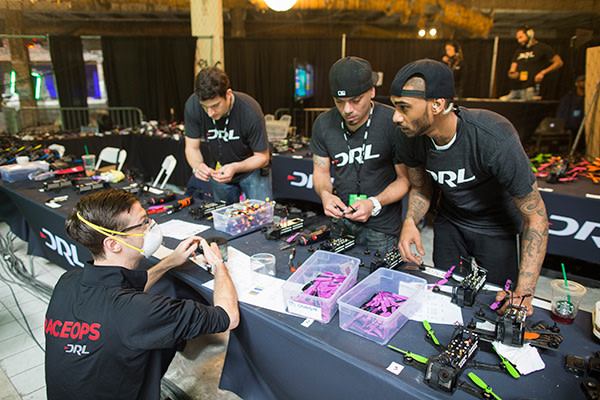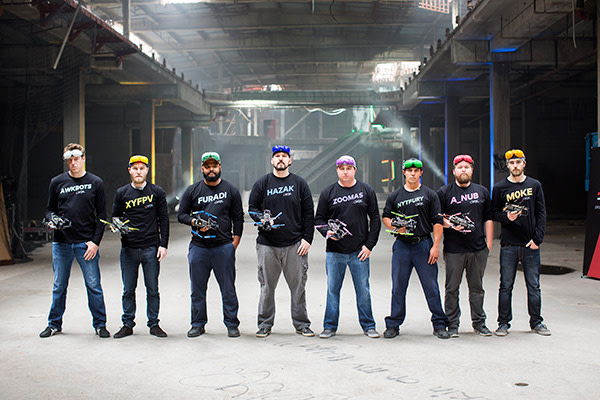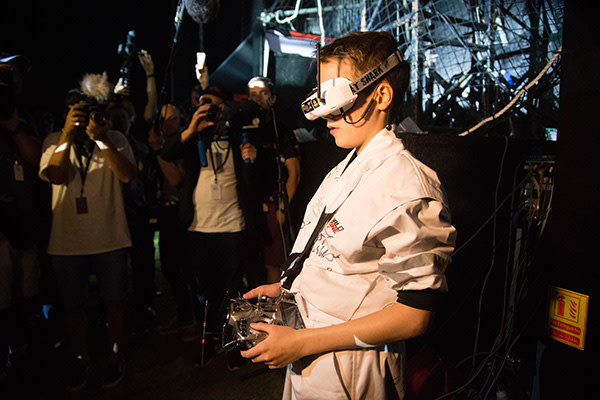Is drone racing the sport of the future?

Simply sign up to the Life & Arts myFT Digest -- delivered directly to your inbox.
On a recent Sunday, in front of a small crowd of spectators in an abandoned indoor shopping mall in South Central Los Angeles, four young men donned goggles and prepared to race their drones. Seated in front of a promotional banner for the incipient Drone Racing League, the men put their thumbs to the sticks of their controllers, awaiting the starting bell.
The drones were mounted on raised platforms a few metres away. Following the classical logic of the hot-rodder, they had been stripped to their essential elements to minimise weight: small rectangular batteries fixed with four propellers, a miniature front-facing camera, and two antennas. In flight, their insectoid appearance was complemented by their vaguely annoying buzz, a sound somewhere between a bumblebee and a dentist’s drill.
The surrounding environment was almost theatrically apocalyptic. Once the Taj Mahal of commerce, the Hawthorne Plaza mall had been abandoned in 1999, and for a time was given over to squatters. Now it was cavernous, dusty, and covered with graffiti. Here and there, though, large neon squares cut through the gloom. These were the racing gates that delineated the boundaries of the course.
An alarm sounded, and the drones were off with a whirr. They rose gently, then tilted forward, gaining speed. They hugged a rusted escalator en route to a second-floor checkpoint, then plunged sprightly through a “vertical hairpin,” dropping 15ft and turning 180 degrees to come racing back past their masters. From behind a curtain of safety netting, the crowd applauded as it passed, but the pilots, frozen in their chairs, could not see them.
As they careened down the straight corridor of the mall they were tracked by a Skycam suspended on cables, and the audience turned its attention from the racecourse to the monitors. Rounding the final turn, two of the drones collided, and skittered across the floor with a series of echoing clicks. The surprised announcer narrated the action over the PA system, while the surviving pair of pilots pushed their aircraft toward the final gate. The victor crossed the finish an arm’s length ahead of his rival. He had covered a full kilometre in less than a minute. As his drone hit the netting behind it, his supporters in the audience cheered and shouted his name. He stood and pumped his fist in the air, but did so gingerly, as a man blind to the world, his consciousness stranded in a small robot on the floor 20m to his left.

. . .
An hour earlier, I’d walked the perimeter of the course with Nicholas Horbaczewski, chief executive of the Drone Racing League. A Harvard MBA who quotes from South Park, Horbaczewski brings a controlled but nerdish boosterism to his managerial role. He first sensed the commercial potential of drones while working for a military distributor selling tactical quadcopters to the US military. After a stint in management at Tough Mudder, the for-profit obstacle-course company, he struck off on his own.
Horbaczewski has a taste for spectacle. The LA course was decorated with ominous props — decaying freeway signs and ersatz piles of rusted metal — and he’d rigged the scoring to reward aggressiveness. The league had brought 10 drones for each participant, and he urged his pilots to push the aircraft to the limit. “I tell them if you don’t crash, you’re not racing hard enough,” he said.
Starting a sports league is famously difficult, as fans of SlamBall (basketball played on trampolines) can attest. But the growing success of e-sports suggests the potential for a new kind of racing fan. The most popular competitive video game of the moment is Defence of the Ancients 2, a multiplayer online battler where top players compete for cash prizes. The finals of last year’s event drew an estimated 20m viewers.

DRL is seeking to tap into that same market: its first event, held in a vacant Miami stadium in January, has so far attracted 11m views online. Novelty is part of the appeal, of course, but gamers — who seem to have a lot of free time on their hands — have a habit of sticking around. In time, though, Horbaczewski hopes to draw fans from traditional motorsports. He plans a worldwide tour, and is scouting for interesting locations, mentioning a disused subway system beneath Stockholm and a decaying amusement park in Japan. “We are raising a generation of pilots,” he told me.
Horbaczewski outlined three ways the league could make money: selling tickets, attracting sponsors, and retailing branded merchandise. He was most enthusiastic about the last, and hoped soon to push his quadcopters to the general public, praising their speed and lightweight manoeuvrability. It’s a booming market; more than a million consumer drones will be sold in the US in 2016. But when I suggested the possibility of a Sunday park-goer getting hit by a branded DRL racing drone travelling at 70mph, Horbaczewski stiffened, then switched to the careful language of limited liability. “Of course,” he said, “there’ll have to be regulations.”
There had better be. Two days earlier, just a few miles to the east of the Los Angeles meet, an amateur pilot had steered his drone into an air-traffic corridor and passed within 100m of a descending Lufthansa passenger jet. LA sheriffs launched a manhunt for the operator, but could not locate him in the surrounding hills. Although likely an accident, the incident made headlines, and aviation authorities graded it a “near-miss.” Pilots have flown drones into buildings; into power lines; into pedestrians; even into themselves. In the past two years, there have been 200 such occurrences in California alone.

. . .
After the first race, I left the audience and entered through a black curtain into the drone pilots’ lounge. There I saw — and smelled — the devolution of the masculine stereotype, from the sweat-and-jet-fuel cocktail of Top Gun to the undeodorised funk of tabletop gaming. The 12 DRL pilots in attendance were exclusively male and wore T-shirts with their racing handles printed in coloured fonts on the front. They received no payment, although their travel and lodging had been covered. In between heats they paced, talked trash, and feverishly watched the leaderboard.
Steve “Zoomas” Zoumas had won the first event in Miami. A clean-shaven Long Island building contractor with a gentle manner, Zoumas attributed his success to his ability to handle his nerves, and explained how he centred himself with deep breaths before each race. “There are plenty of guys on YouTube who are better pilots than me,” he said. “But they can’t handle the pressure.”
Zoumas’ strategy was to grab an early lead and never let go. Like a sprinter, he practised taking off a lot, and, in a typical training session, might go through 30 or 40 battery packs, focusing on getting a good start out of the gate. “I get out in front to put pressure on the other guys,” he said. “Then they can’t do anything but worry about my line.”
Malte Lynen of Düsseldorf had a more scientific approach. A car-racing buff, he’d taken up drone racing after watching a thrilling YouTube video. Now he sought mastery, and the key, he felt, was diligent study. He spent hours on racing forums, reading up on a still evolving set of techniques. His racing handle was “xy.fpv”: x-axis, y-axis, first person view. And what about z? “Sometimes you miss gravity,” he said.
Many of the pilots had backgrounds in motorcycle racing, or skateboarding. Some had experience with remote control cars. All seemed to enjoy video games. But, while I had naively expected them to talk of becoming “one with the machine,” the opposite seemed to be true: the key asset for a drone pilot was the ability to maintain a distance from the goggles’ video feed. The trick was to understand that the drone was a separate entity from oneself, and thus not subject to the same physical rules as the human. Conrad “Furadi” Miller, a former Air Force mechanic from Boise, Idaho, elaborated. “The sensation of flying makes your knees buckle,” he said. “I have to remain seated during the match, or I forget where I am.”
. . .
The second race was less thrilling. The drones’ batteries held only a couple minutes’ charge, and had to be replaced between each heat. The scoring mechanisms were complicated, and it was hard to tell who was winning. By the third race, novelty had given way to tedium. After a while even the crashes were boring, just toys clattering to the floor. Drone racing seemed stuck in the uncanny valley between Formula One and Mario Kart.

Some of my criticisms were shared by Steve Doll, a drone manufacturer who was sponsoring one of the pilots. Standing next to me in the pilots’ area, Doll was on the cusp of turning his hobby into a legitimate profession, but I sensed he was frustrated with the event. “This is hard to watch as a spectator sport,” he said. “You need post-production to make it work.”
Drone racing certainly improves with editing. The DRL’s course design is clever, with drag strips feeding into tighter sections that require expert technical manoeuvring. Spectators cannot see inside those mazelike corridors, where the most exciting action tend to occur. So, while the winner of a DRL heat is decided in under a minute, it is only once the drone’s camera feeds are included, cut with slow-motion replays, and sequenced over a dubstep soundtrack, that the race is really done.
The finished product is compelling, but the league faces other problems. The DRL bills its preselected pilots as the world’s best, but this is not true. They are almost all Americans, for one thing, and selected on the quality of their social media feeds, rather than open competition. Additionally, the drones are all of identical manufacture, making the event a test of pilot skill, but throttling technological innovation.

Doll compared the DRL meet to the first-ever World Drone Prix, a rival event held several days earlier in Dubai and bankrolled by an Emirati prince. There, teams had been given the freedom to select and modify their own gear, and the event had been open to all competitors. The race had been won by Luke Bannister, a previously unknown 15-year-old from Somerset, England, whose team had walked away with a quarter of a million dollars. “That was a real race,” Doll said. “This is more like a game show.”
Aggressive brand management, exclusive athlete contracts, and on-field products better seen on TV: these are the familiar features of America’s corporate sports leagues. The primary financial backer of the DRL is Stephen Ross, the billionaire owner of the National Football League’s Miami Dolphins. (Ross has put up $1m, and is joined by a variety of venture capital firms and several video game executives.) Despite having zero international appeal, NFL franchises are consistently among the most profitable in all of sports, elevating spectacle over subtlety, violence over strategy, and camera angles above all. As the league has grown more dependent on television advertising revenue, the stadium experience has become almost unwatchable; the average NFL game now has roughly 12 minutes of on-field action, yet takes more than three hours to air. That same approach, I felt, was being pushed on drone racing.

The event organisers sensed my dissatisfaction. They suggested I was only seeing half the picture. To truly experience the spectator thrill, they said, I had to wear the goggles.
. . .
In his classic work of nature writing, The Peregrine (1967), author JA Baker tracks a peregrine falcon through a season of hunting. As the falcon marauds its way through the British countryside, Baker follows on foot, tallying its diet of helpless woodland creatures. In the book’s climax, he projects himself into the mind of the bird, imagining the thousand-foot view of an avian predator. “Idly, indifferently, he saw it all, as he swung and swayed round the glittering gun-sight of his eye’s deep fovea, and watched for a flash or spurt of wings at which to aim his headlong flight.”

The drone’s point of view was less poetic: it resembled not that of a soaring bird but an agitated flea. The video quality was poor: to minimise lag and maximise responsiveness, it broadcast in standard definition analogue. A selector on the goggles let me switch between different pilot feeds. I opted for Zoumas, the path-breaker.
With the familiar klaxon, the race began. Zoumas, true to his word, blasted out of the gate, tilting his drone hard and accelerating quickly. He took an aggressive, dangerous route up the rusted escalator, daring his rivals to do the same. He flew through the checkpoint, then cut his propellers, and my stomach fell as he dropped and rotated to nail the vertical hairpin. Racing back through the straightaway corridor, he passed 20ft above the spectators. There, for an instant, I saw myself, my hands gripping the railing in front of me. Quickly I was gone, and, as the craft rounded a sharp corner, my knees involuntarily buckled, as the pilot Miller had warned. Then Zoumas erred. His calculated daring turned to overconfidence. He clipped the gate on the final turn and spun on to the dusty floor, coming to rest with his camera facing upward at a 45-degree angle. From here I stared, grounded, at a spray-painted pillar and watched the other drones fly past. I was disappointed, of course, but it was from this vantage point that I think I saw the future of racing.

Stephen Witt is author of ‘How Music Got Free’, which was shortlisted in the FT and McKinsey Business Book of the Year 2015
Photographs: Kenneth O’Halloran; Michael Brian; Bloomberg
Comments